
The Permanent Court of Arbitration (PCA) is a non-UN intergovernmental organization located in The Hague, Netherlands. Unlike a judicial court in the traditional sense, the PCA provides services of arbitral tribunal to resolve disputes that arise out of international agreements between member states, international organizations or private parties. The cases span a range of legal issues involving territorial and maritime boundaries, sovereignty, human rights, international investment, and international and regional trade. The PCA is constituted through two separate multilateral conventions with a combined membership of 122 states. It is not a United Nations agency, but a United Nations observer.

The Pribilof Islands are a group of four volcanic islands off the coast of mainland Alaska, in the Bering Sea, about 200 miles (320 km) north of Unalaska and 200 miles (320 km) southwest of Cape Newenham. The Siberian coast is roughly 500 miles (800 km) northwest. About 77 square miles (200 km2) in total area, they are mostly rocky and are covered with tundra, with a population of 572 as of the 2010 census.

The Bering Sea is a marginal sea of the Northern Pacific Ocean. It forms, along with the Bering Strait, the divide between the two largest landmasses on Earth: Eurasia and The Americas. It comprises a deep water basin, which then rises through a narrow slope into the shallower water above the continental shelves. The Bering Sea is named after Vitus Bering, a Danish navigator in Russian service, who, in 1728, was the first European to systematically explore it, sailing from the Pacific Ocean northward to the Arctic Ocean.
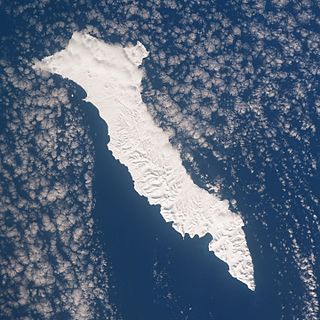
Bering Island is located off the Kamchatka Peninsula in the Bering Sea.
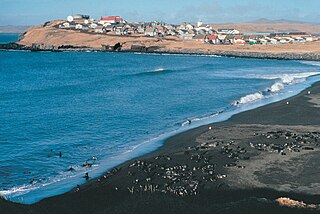
St. Paul is a city in the Aleutians West Census Area, Alaska, United States. It is the main settlement of Saint Paul Island in the Pribilofs, a small island group in the Bering Sea. Saint Paul Island is well known as a birdwatching haven. The population was 479 at the 2010 census, down from 532 in 2000.
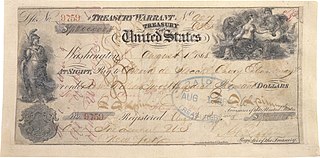
The Alaska Purchase was the United States' acquisition of Alaska from the Russian Empire. Alaska was formally transferred to the United States on October 18, 1867, through a treaty ratified by the United States Senate.
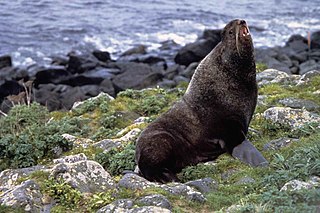
The northern fur seal is an eared seal found along the north Pacific Ocean, the Bering Sea, and the Sea of Okhotsk. It is the largest member of the fur seal subfamily (Arctocephalinae) and the only living species in the genus Callorhinus. A single fossil species, Callorhinus gilmorei, is known from the Pliocene of Japan and western North America.
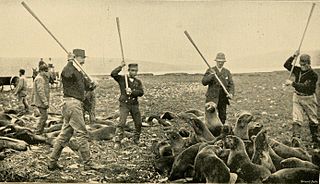
Seal hunting, or sealing, is the personal or commercial hunting of seals. Seal hunting is currently practiced in nine countries: United States, Canada, Namibia, Denmark, Iceland, Norway, Russia, Finland and Sweden. Most of the world's seal hunting takes place in Canada and Greenland.
Saint Paul Island is the largest of the Pribilof Islands, a group of four Alaskan volcanic islands located in the Bering Sea between the United States and Russia. The city of St. Paul is the only residential area on the island. The three nearest islands to Saint Paul Island are Otter Island to the southwest, Saint George slightly to the south, and Walrus Island to the east.

Arbitration is a form of alternative dispute resolution (ADR) that resolves disputes outside the judiciary courts. The dispute will be decided by one or more persons, which renders the 'arbitration award'. An arbitration decision or award is legally binding on both sides and enforceable in the courts, unless all parties stipulate that the arbitration process and decision are non-binding.

St. George Island is one of the Pribilof Islands off the western coast of the U.S. state of Alaska in the Bering Sea. The island has a land area of 90 km2 and a population of about 100 people, all living in its only community, the city of St. George, which encompasses the entire island. The ZIP Code for Saint George Island is 99591.

The Treaty of Saint Petersburg of 1825 or the Anglo-Russian Convention of 1825, officially the Convention Concerning the Limits of Their Respective Possessions on the Northwest Coast of America and the Navigation of the Pacific Ocean, defined the boundaries between Russian America and British claims and possessions of the Pacific Coast, and the later Yukon and Arctic regions of North America. It was agreed that along the coast at the southern tip of Prince of Wales island northward to the 56 parallel, with the island wholly belonging to Russia, then to 10 marine leagues (56 km) inland going north and west to the 141st meridian west and then north to the "Frozen Ocean", the current Alaska/Canadian Yukon boundary, would be the boundary. The coastal limit had, the year before, been established as the limit of overlapping American claims in the parallel Russo-American Treaty of 1824. The Russian sphere in the region was later sold to the United States, eventually becoming the State of Alaska, while the British claim, along the coast to the south of parallel 54°40′ is now the coast of the Canadian province of British Columbia, and for inland regions it defined the western limit of what became the modern day Canadian territory of Yukon. It also defined associated rights and obligations concerning waters and ports in the region. The treaty, in establishing a vague division of coastal Russian interests and inland British interests between 56 and 60 degrees north latitude, led to conflicting interpretations of the meaning of the treaty's wording which later manifested in the Alaska Boundary Dispute between the United States on the one hand, and Canada on the other.
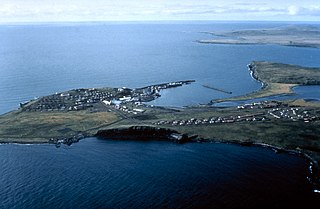
The Seal Island Historic District is a National Historic Landmark District located on the islands of St. George and St. Paul in the Pribilof Islands in the Bering Sea of Alaska. These islands are home to northern fur seal herds which were actively hunted by indigenous populations and later by many nationalities. These islands of the Pribilofs are also the southern end of the range of the polar bear, The North Pacific Fur Seal Convention of 1911 signed by the United Kingdom, Japan, Russia and the United States limited hunting of the seals on these islands; this international treaty was one of the first conservation treaties, and set the stage for subsequent treaties.

The 51st parallel north is a circle of latitude that is 51 degrees north of the Earth's equatorial plane. It crosses Europe, Asia, the Pacific Ocean, North America, and the Atlantic Ocean.

The North Pacific Fur Seal Convention of 1911, formally known as the Convention between the United States and Other Powers Providing for the Preservation and Protection of Fur Seals, was a treaty signed on July 7, 1911, designed to manage the commercial harvest of fur-bearing mammals in the Pribilof Islands of the Bering Sea. The treaty, signed by the United States, Great Britain, Japan, and Russia, outlawed open-water seal hunting and acknowledged the United States' jurisdiction in managing the on-shore hunting of seals for commercial purposes. It was the first international treaty to address wildlife preservation issues.

The Venezuelan crisis of 1895 occurred over Venezuela's longstanding dispute with the United Kingdom of Great Britain and Ireland about the territory of Essequibo and Guayana Esequiba, which Britain claimed as part of British Guiana and Venezuela saw as Venezuelan territory. As the dispute became a crisis, the key issue became Britain's refusal to include in the proposed international arbitration the territory east of the "Schomburgk Line", which a surveyor had drawn half-a-century earlier as a boundary between Venezuela and the former Dutch territory ceded by the Dutch in the Anglo-Dutch Treaty of 1814, later part of British Guiana. The crisis ultimately saw Britain accept the United States' intervention in the dispute to force arbitration of the entire disputed territory, and tacitly accept the US right to intervene under the Monroe Doctrine. A tribunal convened in Paris in 1898 to decide the matter, and in 1899 awarded the bulk of the disputed territory to British Guiana.

Bering Sea Anti-Poaching Operations were conducted in 1891 by the navies and marine corps' of the United States and the United Kingdom of Great Britain and Ireland. Due to the near extinction of the seal population in the Bering Sea, the American and British governments dispatched a squadron of warships to suppress poaching activities, under the command of Charles S. Cotton.

Philippines v. China, also known as the South China Sea Arbitration, was an arbitration case brought by the Republic of the Philippines against the People's Republic of China (PRC) under Annex VII of the United Nations Convention on the Law of the Sea concerning certain issues in the South China Sea, including the nine-dash line introduced by the Republic of China (Taiwan) since as early as 1947. A tribunal of arbitrators appointed the Permanent Court of Arbitration (PCA) as the registry for the proceedings.

US FWS Pribilof was an American refrigerated cargo ship in commission in the fleet of the United States Fish and Wildlife Service (USFWS) from 1964 to 1970 and, as NOAAS Pribilof, in the fleet of the U.S. National Oceanic and Atmospheric Administration′s National Marine Fisheries Service (NMFS) from 1970 to 1975. She ran a cargo service between Seattle, Washington, and the Pribilof Islands – the last of the United States Government "Pribilof tenders" to carry out this function – and also made USFWS and NMFS research cruises in the Pribilofs.


















